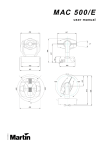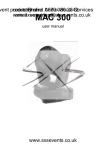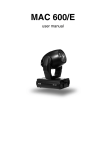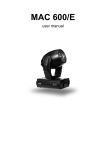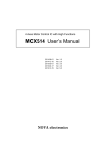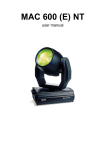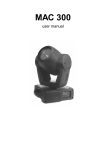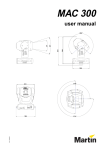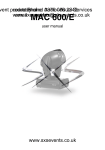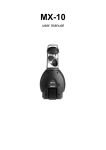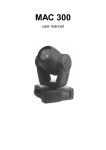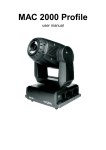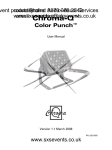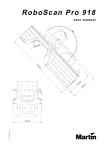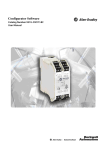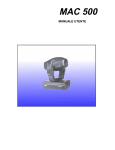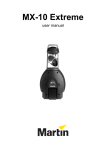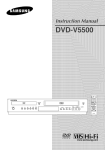Download Lighting - Martin mac500-manual
Transcript
vent production courtesy Phone: ofand Audio-Visual 0870 080 2342 Services www.sxsevents.co.uk email: [email protected] MAC 500/E user manual www.sxsevents.co.uk vent production courtesy Phone: ofand Audio-Visual 0870 080 2342 Services www.sxsevents.co.uk email: [email protected] © 1997 - 2000 Martin Professional A/S, Denmark. All rights reserved. No part of this manual may be reproduced, in any form or by any means, without permission in writing from Martin Professional A/S, Denmark. Printed in Denmark. www.sxsevents.co.uk P/N 35000016, Rev. E vent production courtesy Phone: ofand Audio-Visual 0870 080 2342 Services www.sxsevents.co.uk email: [email protected] Introduction section 1 MAC 500/E safety information................................................................................................... ................................................. 4 section 2 Setup Unpacking .................................................................................................................................................................................... 5 Installing or changing the lamp.................................................................................................................................................... 5 Powering the fixture..................................................................................................................................................................... 6 Rigging......................................................................................................................................................................................... 6 Connecting the serial link ............................................................................................................................................................ 7 section 3 Operation Martin RS-485 control ................................................................................................................................................................. 9 DMX-512 control......................................................................................................................................................................... 9 Controllable effects ....................................................................................................................................................................10 section 4 Control Panel Menu navigation ........................................................................................................................................................................12 Personality settings ....................................................................................................................................................................13 Address and protocol selection ..................................................................................................................................................14 Readouts.....................................................................................................................................................................................14 Manual control ...........................................................................................................................................................................15 Stand-alone sequences ...............................................................................................................................................................15 Utilities.......................................................................................................................................................................................16 section 5 Gobos and Color Filters Gobo specifications............................................................................................................ ........................................................17 Gobo orientation and positions ................................................................................................. .................................................17 Changing rotating gobos ........................................................................................................ ....................................................19 Changing static gobos .......................................................................................................... ......................................................19 Default color filter positions ................................................................................................. .....................................................20 Changing color filters......................................................................................................... ........................................................20 section 6 Maintenance and Basic Service Accessing parts ..........................................................................................................................................................................21 Removing the printed circuit board ...........................................................................................................................................21 Replacing fuses ..........................................................................................................................................................................22 Changing the XLR pin-out.........................................................................................................................................................22 Changing voltage and frequency settings ..................................................................................................................................22 Updating software ......................................................................................................................................................................23 Changing lenses ......................................................................................................................................................................... 24 Replacing the lamp.....................................................................................................................................................................24 Optimizing lamp alignment ....................................................................................................................................................... 25 Installing the optional head shell safety wire.............................................................................................................................25 Maintenance schedule ................................................................................................................................................................25 Cleaning .....................................................................................................................................................................................26 Lubrication .................................................................................................................................................................................26 section 7 Appendices DMX protocol ................................................................................................................... .........................................................27 Messages ....................................................................................................................... ............................................................. 31 Troubleshooting ............................................................................................................... .........................................................32 Circuit board layout ........................................................................................................... ........................................................33 Specifications ................................................................................................................. ............................................................34 www.sxsevents.co.uk 3 vent production courtesy Phone: ofand Audio-Visual 0870 080 2342 Services INTRODUCTION www.sxsevents.co.uk email: [email protected] section 1 Thank you for purchasing the MAC 500/E moving-head spotlight from Martin. Every detail of its construction and programming is designed to make the MAC 500/E7extremely7bright, quiet and reliable. With proper setup and maintenance, it will provide years of trouble-free operation. This manual covers the MAC 500 with magnetic ballast and the MAC 500 E with electronic ballast. “MAC 500/E” refers to both models when describing common features and procedures. The features in software version 1.9 are described. The latest MAC 500/E news and software is available from the Martin web site at http://www.martin.dk. MAC 500/E safety information WARNING! This product is for professional use only. It is not for household use. This product presents risks of lethal or severe injury due to fire and heat, electric shock, ultraviolet radiation, lamp explosion, and falls. ���������������� before powering or installing the fixture, follow the safety precautions listed below and observe all warnings in this manual and printed on the fixture. If you have questions about how to operate the fixture safely, please contact your Martin dealer or call the Martin 24-hour service hotline at +45 70 200 201. To p r o t e c t y o u r s e l f a n d o t h e r s f r o m e l e c t r i c s h o c k • • • • • Disconnect the fixture from AC power before removing or installing the lamp, fuses, or any part, and when not in use. Always ground (earth) the fixture electrically. Use only a source of AC power that complies with local building and electrical codes and has both overload and ground-fault protection. Do not expose the fixture to rain or moisture. Refer any service operation not described in this manual to a qualified technician. To p r o t e c t y o u r s e l f a n d o t h e r s f r o m U V r a d i a t i o n a n d l a m p e x p l o s i o n • • • • Never operate the fixture with missing or damaged lenses and/or covers. When replacing the lamp, allow the fixture to cool for at least 15 minutes before opening the fixture or removing the lamp. Protect your hands and eyes with gloves and safety glasses. Do not stare directly into the light. Never look at an exposed lamp while it is lit. Replace the lamp before usage exceeds the maximum service life, or if the lamp is defective or worn out. To p r o t e c t y o u r s e l f a n d o t h e r s f r o m b u r n s a n d f i r e • • • • • • • • Never attempt to bypass the thermostatic switch or fuses. Always replace defective fuses with ones of the specified type and rating. Keep all combustible materials (for example fabric, wood, paper) at least 1.0 meter (39 inches) away from the fixture. Keep flammable materials well away from the fixture. Do not illuminate surfaces within 1.0 meter (39 inches) of the fixture. Provide a minimum clearance of 0.1 meters (4 inches) around fans and air vents. Never place filters or other materials over the lens. The exterior of the fixture can reach temperatures up to 140° C (284° F). Allow the fixture to cool for at least 5 minutes before handling. Do not modify the fixture or install other than genuine Martin parts. Do not operate the fixture if the ambient temperature (Ta) exceeds 40° C (104° F). To p r o t e c t y o u r s e l f a n d o t h e r s f r o m i n j u r y d u e t o f a l l s • • • • 4 When suspending the fixture above ground level, verify that the structure can hold at least 10 times the weight of all installed devices. Verify that all external covers and rigging hardware are securely fastened and use an approved means of secondary attachment such as a safety cable. Block access below the work area whenever installing or removing the fixture. Do not lift the fixture by its head. www.sxsevents.co.uk MAC 500/E User Manual vent production courtesy Phone: ofand Audio-Visual 0870 080 2342 Services SETUP www.sxsevents.co.uk email: [email protected] section 2 This section describes the steps required to prepare the MAC 500/E for operation. Unpacking The MAC 500/E7package includes: • • • • • 2 Fast-Lock clamp brackets 5-meter XLR-XLR control cable User manual 7 extra gobos 1 spare rotating gobo spring The packing material is carefully designed to protect the fixture during shipment - always use it or a custom MAC 500/ 600 flight case to transport the fixture. X�V[H7�OQ7D**7�UJV7$WK[K7�T��0$[�7[��T[7[�V[([TN7�GGEN7WT[7)�V7�[[�7[)�0J7��T7VJ[7�OQ7L**%Y These flight cases can be identified by the outside measurements: 860 mm (34") from bottom to top, including wheels, on the outside. Suitable flight cases measure 894 mm (35.2") from bottom to top, including wheels. Installing or changing the lamp WARNING! Disconnect the fixture from AC power before proceeding. Always wear safety goggles to protect your eyes and allow a hot lamp to cool for at least 15 minutes before removing it from the fixture. The MAC 500/E is designed to work with the Philips MSR-575/2, Philips MSD-575, Osram HSD-575, or the Osram HSR-575/2 discharge lamps. S)KVWU)7W)R7�VJ[T7W(�7(WR7�W(W[7VJ[7�UV0T[��The lamp holder is pre-adjusted at the factory; precise alignment may be necessary due to slight variations between lamps. The procedure is described on page 25. 1. The MAC 500/E must be cool and isolated from AC power. Remove the 2 screws holding the lamp assembly. Gently remove the assembly. 2. If changing the lamp, remove the old lamp from the socket. 3. Holding the new lamp by its ceramic base (do not touch the glass), carefully insert it firmly and squarely into the lamp socket. 4. Clean the glass bulb with the cloth supplied with the lamp, particularly if your fingers touch the glass. A clean, lint-free cloth wetted with alcohol may also be used. 5. Re-insert the lamp assembly and replace the screws. www.sxsevents.co.uk Setup 5 vent production courtesy Phone: ofand Audio-Visual 0870 080 2342 Services P owww.sxsevents.co.uk w email: e r i n g t h e f [email protected] xture 6. Before turning the lamp on, reset the RL AH and RL ST counters. See “Readouts” on page 14. WARNING! For protection from dangerous electric shock, the fixture must be grounded (earthed). The AC mains supply shall be fitted with a fuse or circuit breaker and ground-fault protection. Check voltage and frequency settings 6J[71�VW[7W)�7�T[,0[)$R7K[VVU)K7(0KV7(WV$J7VJ[7�$W7OQ7��F[T7K0��R� Operating at the incorrect setting can result in poor light output, shortened lamp life, overheating and damage to the fixture. The settings are printed on the serial number label on the bottom of the base: if the voltage does not match the local supply or the frequency (50/ 60 Hz) is different, then the ballast and/or transformer must be rewired as described on page 22. Install a plug on the power cord You may need to install a cord cap that fits your supply on the power cable. Following the manufacturer’s instructions, install an approved 3-prong grounding-type plug that fits your supply. Connect the wires to the pins as listed below. The table shows some possible pin identification schemes; if the pins are not clearly identified, or if you have any doubts about proper installation, consult a qualified electrician.7 Wire Pin Marking Screw (US) brown live “L” yellow or brass blue neutral “N” silver yellow/green ground green When ready to operate, connect the MAC 500/E directly to AC power.7�7)�V7$�))[$V7UV7V�7W7�U(([T7KRKV[(I7��U)7K� (WR7�W(W[7VJ[7�UV0T[ To apply power, set the power switch on the base to the “I” position. Rigging WARNING! Use 2 clamps to rig the fixture. Lock each clamp with both fasteners. The 1/4-turn fasteners are locked only when turned fully clockwise. Attach an approved safety cable to the base. The MAC 500/E can be placed directly on the stage floor or rigged in any orientation on a truss. The integrated FastLock system enables quick and easy fastening of the clamp adapters in 4 different positions as shown below. See page 35 for a list of suitable clamps available from Martin. 6 1. Verify that the rigging clamps (not included) are undamaged and can bear at least 10 times the weight of the fixture. Bolt the clamps securely to the clamp brackets with a grade 8.8 (minimum) M12 bolt and lock nut, or as recommended by the clamp manufacturer. 2. Tip the MAC 500/E on its side or install the clamps while the fixture is in the flight case. 3. Align a clamp with 2 mounting points. Insert the fasteners into the base and turn both levers a full 1/4-turn clockwise to lock. Install the second clamp. 4. Verify that the structure can bear at least 10 times the weight of all installed fixtures, clamps, cables, auxiliary equipment, etc. www.sxsevents.co.uk MAC 500/E User Manual vent production courtesy Phone: ofand Audio-Visual 0870 080 2342 Services www.sxsevents.co.uk email: [email protected] safety wire attachment point arrow points to front (neutral pan) 5. Working from a stable platform, hang the fixture on the truss. The front of the fixture is indicated by the arrow on the base. 6. Install a safety wire that can bear at least 10 times the weight of the fixture. The attachment point is designed to fit a caribiner clamp. Never use the carrying handles for secondary attachment. 7. Tighten the rigging clamps securely to the structure. 8. Verify that there are no combustible materials or surfaces to be illuminated within 1 meter of the fixture, and that there are no flammable materials nearby. IMPORTANT! When rigging the fixture within 1 meter of other fixtures, avoid illuminating one fixture with another. The intense light can melt plastic parts. Connecting the serial link Tips for building a serial link 1. Use shielded twisted-pair cable designed for RS-485 devices: standard microphone cable cannot transmit DMX data reliably over long runs. For links up to 300 meters (1000 ft.) long, you can use 24 AWG, low capacitance, 85-150 ohm characteristic impedance, shielded cable with 1 or more twisted pairs. For runs up to 500 meters (1640 ft.) use 22 AWG cable. Use an amplifier if the serial link exceeds 500 meters. 2. Never use a “Y” connector to split the link. To split the serial link into branches use a splitter such as the Martin 4-Channel Opto-Isolated RS-485 Splitter/Amplifier. 3. Do not overload the link. Up to 32 devices may be connected on a serial link. 4. Terminate the link by installing a termination plug in the output socket of the last fixture on the link. The termination plug, which is simply a male XLR connector with a 120 ohm, 0.25 watt resistor soldered between pins 2 and 3, “soaks up” the control signal so it does not reflect back down the link and cause interference. If a splitter is used, terminate each branch of the link. Connecting fixtures The MAC 500/E has locking 3-pin data input and output sockets that can be configured for use with either DMX or Martin Protocol controllers. ���������������������������������������������������������, i.e., pin 1 to shield, pin 2 to signal (-) and pin 3 to signal (+). 3-pin to 3-pin Phase-Reversing Cable 3-pin to 5-pin Phase-Reversing Cable 5-pin to 3-pin Phase-Reversing Cable 5-pin to 3-pin Straight Cable 3-pin to 5-pin Straight Cable Connections Connections Connections Connections Connections Male Female Male Female Male Female Male Female Male Female 1 2 3 1 2 3 1 2 3 1 2 3 4 5 1 2 3 4 5 1 2 3 1 2 3 4 5 1 2 3 1 2 3 1 2 3 4 5 P/N 11820006 P/N 11820002 P/N 11820003 P/N 11820005 www.sxsevents.co.uk Setup P/N 11820004 7 vent production courtesy Phone: ofand Audio-Visual 0870 080 2342 Services www.sxsevents.co.uk email: [email protected] 1. Connect the controller’s data output to the MAC 500/E’s data input. For a • 2. 3. 8 DMX controller with 5-pin output: use a cable with 5-pin male and 3-pin female connectors such as P/N 11820005. Pins 4 and 5 are not used. • DMX controller with 3-pin output: use a cable with 3-pin male and female connectors such as the one supplied. • Martin RS-485 Protocol controller: use a phase-reversing cable, such as P/N 11820006, with 3pin male and female connectors or reconfigure the XLR output. Continue the link: connect the output of the fixture closest to the controller to the input of the next fixture. Use a phase-reversing cable when connecting a DMX-standard (pin 3 +) device to a Martin-standard (pin 3 -) device. Insert a male 120 Ω XLR termination plug in the output of the last fixture on the link. www.sxsevents.co.uk MAC 500/E User Manual vent production courtesy Phone: ofand Audio-Visual 0870 080 2342 Services OPERATION www.sxsevents.co.uk email: [email protected] section 3 This section describes the MAC 500/E’s controllable effects and the options for customizing them for your application. Option selection is described in the next section. Martin RS-485 control The MAC 500/E may be controlled with the Martin 3032 controller with version 2.04 or later software. To respond to the controller, either the protocol setting (P SET ) must be set to Martin (MA RT ) as described in the previous section, or automatic protocol detection (SPEC /AU TO ) must be enabled. If automatic protocol detection is enabled, send a dummy command and wait 1 second to allow the fixture to respond before sending real commands. DMX-512 control The MAC 500/E may be operated with USITT DMX512 controllers in 4 modes that combine tracking or tracking/vector movement with 8-bit or 16-bit pan/tilt resolution. Tr a c k i n g c o n t r o l Tracking is available in all 4 DMX modes. With tracking control, the controller calculates the positions along the path between an effect’s starting point and it’s ending point. It uses the fade time to calculate the change (delta) of each update or refresh, which the fixture “tracks.” For smooth movement with any fade time, the MAC 500/E has a filter algorithm that looks at several position updates (samples), and calculates the ideal speed. This algorithm is adjustable to compensate for controllers that calculate position changes unevenly. In most cases the default settings work well. If movement is not satisfactory there are 2 parameters that can be adjusted. The first is the calculation method used and is selected under SP EC/ TRAC /MO dE . MOd1 , the default, calculates speed based on the absolute value of the change in DMX; it is the best choice with controllers that calculate intermediate positions that are close to the line of travel. MO d2 uses the real value of the DMX delta to calculate speed and is better if the intermediate positions stray significantly from the line of travel. The second parameter is the number of position updates used to calculate speed. The level is adjustable between 1 and 10 under SP EC/ TRAC /CA L . Increasing the number of samples increases the distance over which speed is calculated, making movement smoother but less responsive to sudden changes. The ideal settings for both parameters will vary from controller to controller: experiment for best results. The real value algorithm (MOd2 ) is recommended when using the MAC 500/E with the Martin Lighting Director system. Ve c t o r c o n t r o l With vector control, available in DMX modes 3 and 4, the fixture is given just 1 position - the end position - and a speed, which is set on a separate channel. �T7K(��VJ7(�1[([)VN7VJ[7�W�[7VU([7(0KV7[7K[V7V�7*N7U[N7VJ[7[��[$V7P0(�K �T7PK)W�K7�T�(7�)[7��KUVU�)7V�7VJ[7)[V With controllers that do not have programmable fade times, vector control provides a way to set speed. Because the end point and speed are known from the beginning, vector control results in smooth movement regardless the fade time or the controller’s processing power. The speed channels allow vector control to be turned off, resulting in tracking control. In addition, they offer a “blackout speed,” described below, and overrides of the P TSP (pan/tilt speed), MOd E (studio mode), and SC UT (shortcuts) personality settings. When blackout speed is enabled, effects move at full speed. The dimmer/shutter closes while the effects move to make the transition invisible. Dimmer/shutter strobe and pulse effects, however, override the blackout command. 8-bit versus 16-bit pan/tilt resolution With 8-bit pan/tilt resolution, the pan and tilt are divided into 256 equal increments. Finer position control and smoother movement is provided in the 16-bit modes, which divide the full pan range into 32,768 increments and the full tilt range into 45,567 increments. www.sxsevents.co.uk Operation 9 ocourtesy n t r o l l a b l e ePhone: f f e cof t and s vent Cproduction Audio-Visual 0870 080 2342 Services www.sxsevents.co.uk email: [email protected] All moving effects are reset to a “home” position when the fixture is powered up. The fixture can also be reset via DMX if DMX reset (SPEC /dR ES ) is enabled. There is also a combination of DMX values that allows you to reset the MAC 500/E even if this feature is disabled; see the DMX protocol for details. An on-the-fly position correction system monitors the position of the color wheels, fixed-gobo wheel, and rotating gobos. If an error is detected, the shutter closes and the effect is reset to its home position. Normal operation resumes immediately thereafter. This feature can be disabled by setting effects feedback ( S PEC/ EFF b ) to OFF . General operation may be optimized for speed or quietness with the studio mode setting (S PEC /MO dE ). The menu setting may be overridden via DMX using the effects speed channel in DMX modes 3 and 4. Lamp The MAC 500/E can be set to automatically strike the lamp within 90 seconds of being powered on by setting the Automatic Lamp On (S PEC /ALO N ) personality to ON. A delay determined by the fixture address prevents all lamps from striking at the same time. If Automatic Lamp On is set to off (default), the lamp remains off until a “lamp on” command is sent from the controller. A peak of electric current that can be many times the operating current is drawn for an instant when striking the lamp: striking many lamps at once may cause a voltage drop large enough to prevent lamps from striking or trip the main circuit breaker. Avoid this by programming a “lamp on” sequence that strikes lamps one at a time at 5 second intervals. Power to the lamp can be turned off from the controller if the DMX Lamp Off (SP EC/d LOF ) feature is enabled. There is also a combination of DMX values that allows you to turn off the lamp even if this feature is disabled; see the DMX protocol. Z[7$WT[�0: it is not possible to strike the lamp within 8 minutes of having switched it off. The MAC 500/E will store a “lamp on” command and strike the lamp automatically when the 8 minutes have elapsed. With the MAC 500 E, lamp power falls to 400 watts for cooler operation and longer lamp life when the shutter is closed for 10 seconds. Power instantly returns to full when the shutter opens. Reduced power mode can also be forced - with the shutter open - by setting channel 1 to a DMX value from 73 to 79. Pan and tilt The moving head pans 440° and tilts 306°. Movement may be optimized for speed by setting the pan/tilt speed (PTS P ) personality to F AST , or for smoothness by setting it to S LOW. The setting may be overridden on the speed channel in vector mode. Setting the movement speed to “blackout” in vector mode causes the shutter to black out the light while the mirror is moving. The pan and tilt channels (DMX) can be inverted and/or swapped for convenience using the pan/tilt (PAT I ) menu. Color wheels The MAC 500/E has 2 9-position-plus-open color wheels, yielding a total of 100 possible combinations. The 4 temperature correction filters and 14 dichroic colors combine in 67 useful ways that can be called on 1 DMX channel. Both wheels can be scrolled, allowing for split color effects, snapped to fixed positions, and continuously rotated in both directions at different speeds. The 67 colors can be called randomly on DMX channel 4. The Shortcuts (S PEC /SC UT ) setting determines whether the wheels take the shortest path to the next position or turn in one direction only. The setting may be overridden on the speed channel in vector mode. Setting the color speed to “blackout” in vector mode causes the shutter to black out the light while the wheels are moving. Focus The beam may be focused from 2 meters (6.5 feet) to infinity. The beam angle with the standard lenses is 17°. An optional 23.5° wide-angle lens set is available as well. See “Accessories” on page 35. Fixed (static) gobos There are 2 operating modes available for the fixed-gobo wheel, which has 9 positions for metal gobos plus an open position. In “fixed” mode (SPE C/gM Od/ FIX ), the wheel steps between fixed positions and shakes at variable speeds. In “scroll” mode (S PEC /gM Od/ SCRL ), the wheel scrolls continuously, shakes at 1 speed, and rotates in 2 directions at variable speed. Setting the fixed-gobo speed to “blackout” in vector mode causes the shutter to black out the light while the wheel turns from one position to another. 10 www.sxsevents.co.uk MAC 500/E User Manual vent production courtesy Phone: ofand Audio-Visual 0870 080 2342 Services www.sxsevents.co.uk email: [email protected] The Shortcuts (SP EC/ SCUT ) setting determines whether the gobo wheel takes the shortest path to the next position or turns in one direction only. The setting may be overridden on the speed channel in vector mode. Rotating gobos The MAC 500/E has 5 rotating positions for glass or metal gobos. Gobos may be rotated in both directions at varying speeds or indexed to any position. The function and gobo are selected on channel 5 and the velocity or index position are selected on channel 6. Setting the rotating-gobo speed to “blackout” in vector mode causes the shutter to black out the light while the wheel turns from one position to another and, if indexing is selected, while the gobo rotates between positions. To change the gobos, see “Gobo orientation and positions” on page 17. Iris The iris diameter ranges from 100 to 15 percent open. There are 6 variable/random pulsating iris effects callable on channel 9. These can be disabled by switching DMX Macros (SP EC/d MAC ) off. The iris reflection reduction setting (SPE C/I RR ) closes the iris slightly from full open to eliminate a halo effect seen in very early units. Rotating prism / variable frost The 3-facet prism can rotate in both directions at varying speeds. There are 8 preprogrammed macros that combine the prism with rotating gobos on channel 10. These can be disabled by switching DMX Macros (SP EC/ dMA C ) off. Setting the prism speed to “blackout” in vector mode causes the shutter to black out the light while the prism moves in and out. An optional frost filter may be installed in place of the rotating prism to provide a variable frost effect. If the frost filter is installed, the fixture type personality (S PEC / F TYP ) must be set to “F ROS ” to enable the frost variation of the protocol. Dimmer / shutter The mechanical dimmer/shutter system provides smooth, high-resolution 100 percent dimming, “instant” open and blackout, random and variable strobe effects up to 23 Hz, and random and variable pulses in which the dimmer snaps open and slowly dims or snaps closed and slowly opens. The pulse and random strobe effects can be disabled by switching DMX Macros (S PEC /dM AC ) off. The Dimmer Mode (SPE C/dM Od ) setting allows you to select between linear or simulated tungsten fade curves. The fade time must be 0 to simulate tungsten dimming. www.sxsevents.co.uk Operation 11 vent production courtesy Phone: ofand Audio-Visual 0870 080 2342 Services CONTROL PANEL www.sxsevents.co.uk email: [email protected] section 4 The 4-digit LED control panel on the front of the MAC 500/E allows you to set the address and personalities, read lamp hours and other information, calibrate effects, control the fixture manually, and run stand-alone tests and demo programs. Most of these functions may be performed remotely via the serial link with the MPBB1 Uploader The display can be flipped for easy reading by pressing the [↑] and [↓]�keys simultaneously. The intensity is adjustable and the display can be set to go out 2 minutes after the last key-press. Menu navigation The DMX or Martin address, depending on the protocol setting, and any error messages are displayed when the MAC 500/E is turned on. To enter the menu, press [MENU]. Use the [↑] and [↓]�keys to move within the menu. To select a function or submenu, press�[ENTER]. To escape a function or menu, press [MENU]. Address/ Messages PSET dAdr MAdr TIME AdJ CAL PATI MAN dMXL Po H RST P OF SWAP RST STCO SHUT RPoH L ON T OF PINV TINV L ON LA H LoFF d OF LoFF .... RLAH HEAd C1OF SHUT E SP LSTR dIM COL1 COL2 Fgob Rgob FOCU IRIS PRIS C2OF dIM RGOF COL1 FGOF COL2 RLST TSEQ VER SPEC DEM1 CPU FTYP PAN TILT FOCU SEQ FEbA dISP dEMO PTSP dISP dINT dLOF DEM2 FOOF Fgob MINP MAXP MINT MAXT FOCU SEQ Rgob PATI FOCU dRES ALON FEbA dFSE FACT CUS1 CUS2 CUS3 IRIS dFOF PRIS/ FROS AUTO PAN UPLd TILT TEMP bASE HEAd PCbT SCUT IRR FTST dMAC MOdE dMOd EFFb TRAC MOdE CAL gMOd FIX SCRL 12 www.sxsevents.co.uk MAC 500/E User Manual ecourtesy r s o n a l i t y s ePhone: t t i nof gand s vent Pproduction Audio-Visual 0870 080 2342 Services www.sxsevents.co.uk email: [email protected] Personality Pan/tilt speed Pan/tilt swap Pan inverse Tilt inverse Fixture type Display on/off Path Dimmer mode Pan/tilt feedback Effects feedback Iris reflection reduction Normal pan and tilt control ON Reverse DMX pan control, right O FF Normal pan control, left O FF P RIS Operate with rotating prism F ROS Operate with optional variable frost ON Display stays on O FF Display goes out 2 minutes after last key press 10 - 100 Adjust display intensity ON Enable DMX lamp off command O FF Disable DMX lamp off command* ON Enable DMX reset command O FF Disable DMX reset command* ON Lamp strikes automatically within 90 seconds of power on O FF Strike lamp from controller ON Enable automatic protocol detection O FF Disable automatic protocol detection MOd1 Absolute delta value algorithm (for most controllers) MOd2 Real delta value algorithm 1 - 10 Tracking mode sample level - default is 6. Higher levels give smoother movement but slower acceleration. ON Color wheels and fixed-gobo wheel turn the shortest direction* O FF Wheels turn same direction* ON Enable DMX-selectable macros and pulsating effects O FF Disable DMX-selectable macros and pulsating effects N ORM Optimize effects for speed S TUd Optimize effects for silence F IX Static gobo wheel steps between full positions S CRL Static gobo wheel scrolls continuously N ORM Normal dimming curve T UNG Simulated tungsten dimming curve ON Enable pan/tilt position correction system OFF Disable pan/tilt feedback. Setting not saved ON Enable feedback from magnetic sensors on color wheels, fixed-gobo wheel, and rotating-gobo index O FF Disable feedback from magnetic sensors ON Iris opens 95 percent. Recommended for early units only O FF Iris opens 100 percent SPEC/ALON SPEC/TRAC/CAL � left � right Reverse DMX tilt control, down � up Normal tilt control, up � down SPEC/dRES SPEC/TRAC/MOdE Fixed gobo mode O FF SPEC/dISP Tracking algorithm Studio mode Map DMX pan control to tilt channel and vice versa S PE C/ FT YP SPEC/AUTO DMX macros ON ON Automatic protocol detection Shortcuts Optimize movement for smoothness* PATI/TINV SPEC/dLOF Tracking samples S LOW PATI/PINV DMX lamp off Automatic lamp on Optimize movement for speed* P AT I/ SW AP SPEC/dINT Effect (Default settings shaded.) F AST P TS P Display intensity DMX reset Options SPEC/SCUT SPEC/dMAC SPEC/MOdE SPEC/gMOd S PE C/ dM Od SPEC/FEbA SPEC/EFFb SPEC/IRR www.sxsevents.co.uk * Setting may be overridden via DMX. See the protocol for details. Control Panel 13 dcourtesy d r e s s a n d pPhone: roto cand o l s e l eAudio-Visual ction vent Aproduction of 0870 080 2342 Services www.sxsevents.co.uk email: [email protected] One of the operating modes shown below must be selected. Factors to consider when selecting a mode will depend on your controller and are discussed in the previous section. Maximum flexibility is provided in mode 4. Each fixture must be assigned its own channels to receive instructions from the controller. The address, also known as the start channel, is the first channel used. Addresses are independent of the physical link: they may be set in any convenient order. Two MAC 500/Es may share the same address; however, they will receive the same instructions and independent control will not be possible. Mode Martin DMX 1 DMX 2 DMX 3 Tracking DMX 4 Movement speed Vector Tracking and/or Vector Pan/tilt resolution 16 bit 8 bit 16 bit 8 bit 16 bit Channels required 2 12 14 14 16 1. Apply power to the MAC 500/E. 2. If you want to change settings while the MAC 500/E is in a flight case, push [MENU] and [ENTER] simultaneously to disable pan and tilt reset. The partial reset procedure can take 2 - 3 minutes and will result in error messages being displayed; this is not a fault with the fixture. 3. Press the [MENU] key and then press [↑] or [↓] until the display shows P SET. Press [ENTER]. 4. Press [↑] or [↓] until the desired protocol (Martin, or DMX mode 1, 2, 3, or 4) appears on the display. Press [ENTER] to confirm. 5. Press [↑] or [↓] until the display shows dAd r (to set a DMX address) or M Adr (to set a Martin address). Press [ENTER] to confirm. 6. Press [↑] or [↓] to select the address. Press [ENTER] to confirm. 7. Press [MENU] to return to the main menu. The address is displayed. Readouts U s a g e r e a d o u t s ( T IME) Read the total number of power-on hours (Po H ), power-on hours since last reset (RP oH ), total lamp hours (LA H ), lamp hours since last reset (RL AH ), total number of lamp strikes (L STR ), and the number of lamp strikes since last reset (RLS T ). The resettable counters may be used to track overall usage and lamp life. To reset to zero, display the readout and then press [↑] for 5 seconds. D M X v a l u e r e a d o u t s ( dMX L ) Read the DMX start code (STC O ) and DMX values received for each effect. This is an easy way to check that the DMX start code is 0 and that the fixture is receiving the expected DMX values. S o f t w a r e v e r s i o n r e a d o u t s ( VE R) Read the version number of the CPU software (CPU ), feedback circuit software (FeB A ), and display module software (dIS P ). The CPU software version is also displayed for a moment at power up. Te m p e r a t u r e r e a d o u t s ( SPE C/ TEM P) Read temperature in the base (bASE) and head (HEAd) in Celsius. Temperatures below 25° C are shown as - 25 ; temperatures above 100° C are shown as + 100 . The7temperature sensors are calibrated at the factory and adjustment should not be necessary. The following procedure calibrates the sensors if they give no or faulty readings. 14 1. Allow the unit to cool to room temperature (powered off for at least 4 hours). 2. Measure the room temperature in Celsius. (To convert F° to C°, subtract 32° and then multiply by 0.555.) 3. Power up the unit and allow it to reset. www.sxsevents.co.uk MAC 500/E User Manual vent production courtesy Phone: ofand Audio-Visual 0870 080 2342 Services www.sxsevents.co.uk email: [email protected] 4. Press the [MENU] and [↓] keys at the same time and hold them for 3 seconds until “25” shows in the display. 5. Press the [↑] and [↓] keys until the display shows the temperature measured. 6. Press [ENTER] to save the setting. Manual control M a n u a l c o n t r o l ( MA N) The manual control menu permits you to do the following without a controller: • • • • • • • • • • • reset the fixture (RST ) turn the lamp on and off (L ON , Lo FF ) open, close, and strobe the shutter at 3 speeds (S HUT ) control the dimmer (dIM ) move the color wheels to each position and scroll them at 3 speeds (COL 1 , C OL2 ) move the fixed-gobo wheel to each position (F gob ) move the rotating-gobo wheel to each position and rotate the gobos at 3 speeds (Rg ob ) control the focus (FO CU ) control the iris (IRI S ) insert and rotate the prism (PRI S ) at 3 speeds, or, if a frost filter is installed, vary the frost (F ROS ) control pan and tilt (PAN , TI LT ) A d j u s t m e n t ( AdJ ) The adjustment menu provides manual control for making mechanical adjustments. These should be performed by a qualified technician. The menu provides functions to reset the fixture (RST ), turn on and off the lamp (L ON , LoF F ), control all effects in the head (HEAd), and move the head to the home and extreme positions (P ATI ). The HEA d submenu allows the technician to: • • • • • open, close, and strobe the dimmer/shutter (dIM ) move the color and gobo wheels through their positions (CO L1 , COL 2 , F gob , Rg ob ) move the focus lens to its extreme positions (F OCU ) open and close the iris (IRIS ) insert and rotate the prism (PRI S ) Stand-alone sequences D e m o n s t r a t i o n p r o g r a m s ( dEMO ) This menu offers 2 preprogrammed demonstrations. Demo 1 shows each effect individually and in combination with others at a set home position. Demo 2 pans and tilts within a defined area and shows various effect combinations. Before running demo 1, set the pan/tilt position ( PA N , TIL T ) to a good location for viewing the effects and then focus (FO CU ) the beam. Select SEQ to run the demo. Demo 2 is similar but instead of defining a home position, you define an area such as a screen or wall by setting the minimum and maximum pan and tilt positions (MI NP, M AXP, MIN T, MAX T ). Focus the beam in the center of the area. Te s t s e q u e n c e s ���������������TSEQ ���Run a general test of all effects. ����������������������������SPEC �PCBT �� This menu provides 4 tests of the circuit board for service use: TI , T2 , T3 , and LEd . ��������������S PEC �F TST �: This menu provides an effects test (E TST ), a movement test (MTS T ), and a sensor test (S TST ) used for quality control. The sensor test includes programs for testing sensors on the color and gobo wheels (C OL1 , CO L2 , Rgo b , and F gob ). www.sxsevents.co.uk Control Panel 15 t courtesy ilities vent Uproduction Phone: ofand Audio-Visual 0870 080 2342 Services www.sxsevents.co.uk email: [email protected] Calibration (CAL) The calibration menu allows you to adjust the effects to achieve total uniformity between fixtures: it is not a substitute for mechanical adjustment. Select dimmer/shutter (d OF ), color wheels (C1 OF, C2 OF ), rotating-gobo wheel (RGO F ), fixed-gobo wheel (FG OF ), or focus (FOO F ) and adjust the effect’s offset with the arrow keys. Offsets are adjustable from 1 to 255 for all effects except the fixed-gobo wheel, which is adjustable from 127 to 129. Press [ENTER] to save the calibration. R e s e t d e f a u l t o f f s e t s ( S PEC/ dFO F) Reset all calibrations to their factory defaults. Select dFO F and press [ENTER] when S URE is displayed. R e s e t d e f a u l t p e r s o n a l i t y s e t t i n g s ( SPEC / d FSE/ F ACT) Return all personality settings (not calibrations) to their factory defaults. Select F ACT and press [ENTER] when LOA D is displayed. C u s t o m c o n f i g u r a t i o n s ( SPE C/ dFSE / C US1 , CU S2, CUS3 ) Save and load 3 sets of custom configurations. To save a custom configuration, adjust the settings as desired, go to CUS 1 , C US2 , or CU S3 and press [ENTER] when SA VE is displayed. To load a custom setting, select it and press [ENTER] when L OAD is displayed. U p l o a d m o d e ( UPL d ) Upload mode prepares the MAC 500/E to receive control software. It is normally engaged automatically when using the MPBB1 or MP-2 uploaders� In certain circumstances, however, you may have to set upload mode manually as described under “Updating software” on page 23. 16 www.sxsevents.co.uk MAC 500/E User Manual vent production courtesy Phone: ofand Audio-Visual 0870 080 2342 Services GOBOS AND COLOR FILTERS www.sxsevents.co.uk email: [email protected] section 5 The MAC 500/E has 5 rotating positions for glass or metal gobos, 9 static positions for metal gobos, and 9 positions for interchangeable dichroic glass color filters in special holders. This section describes how to replace these items. Gobo specifications For best results, MAC 500/E gobos should meet the following specifications. Glass gobos • • • • • Coating: ................................................................................................. dichroic or enhanced aluminum Material: ........................................................................................ high temperature, Borofloat or better Thickness:............................................................................................................................. 1.1- 4.0 mm Outside diameter:........................................................................................................ 27.9 + 0 /- 0.3 mm Maximum image diameter:............................................................................................................23 mm Glass gobos should be made with the artwork reversed on the coated side. This orientation gives the best focus but is not critical. We do not recommend using chrome-coated glass gobos in the MAC 500/E. They absorb more heat than enhanced aluminum gobos and are likely to break or oxidize. If used, their lifetime can be extended somewhat by inserting the gobos with the coated side towards the lamp. Metal gobos • • • • Material: ...................................................................................................................................aluminum Thickness:.....................................................................................................................................0.5 mm Outside diameter:........................................................................................................ 27.9 + 0 /- 0.3 mm Maximum image diameter:............................................................................................................23 mm *Steel metal gobos may give acceptable short term performance. Gobos less than 0.5 mm thick may need to be secured with a drop of high temperature silicone adhesive when used in the static positions. Gobo orientation and positions Glass gobos X�V[H7&WKK7��K7(WR7[70K[�7U)7VJ[7T�VWVU)��7FJ[[7�)R76J[R7WT[7V��7VJU$7��T70K[7U)7VJ[7KVWVU$��7FJ[[ For correct projection of text and images, the side with the true image must be installed facing in, towards the lamp. For best focus, the coated side of glass gobos should face out, away from the lamp. Textured glass gobos must be inserted with the smooth side facing in, towards the lamp. Textured Gobos Coated Glass Gobos Uncoated side towards lamp When an object is held up to the uncoated side, there is a space between the object and its reflection. The edge can be seen through the uncoated side. Smooth side towards lamp Coated side towards stage When an object is held up to the coated side, there is no space between the object and its reflection. The edge cannot be seen through the coated side. Textured side towards stage www.sxsevents.co.uk Gobos and Color Filters 17 vent production courtesy Phone: ofand Audio-Visual 0870 080 2342 Services www.sxsevents.co.uk email: [email protected] Metal and image gobos The metal gobos supplied with the MAC 500/E may be used in either wheel. They are black on one side to reduce reflections; the black side must face out, away from the lamp. For correct projection of text and images, the side with the true image must be installed facing in, towards the lamp. Black side towards stage Metal Gobos Reflective side towards lamp Reversed image towards stage Image Gobos Correct image towards lamp Default gobo layout Rotating-gobo wheel Fixed-gobo wheel Gobo wheels as seen from front, in open position. Position 1 2 3 4 5 6 7 8 9 Rotating gobo wheel Triangle Bar Fan Thin bars Grid ball - - - - 43076004 43076002 43076006 43076005 43076011 Cone Dots Lotus Bricks Clouds Machine Bamboo Threads Pling 43076012 43076013 43076014 43076015 43076016 43076017 43076018 43076019 43076020 Static gobo wheel Loose rotating gobo fix If a rotating gobo becomes a little loose and spins in the holder (losing its indexed position), remove the gobo, apply three dots of red, high-temperature silicone (P/N 37001201) in the holder recess, and let the silicone harden before replacing the gobo. The additional friction will keep the gobo from spinning. 18 www.sxsevents.co.uk MAC 500/E User Manual hcourtesy a n g i n g r o t aPhone: t i n gof g o b o s Audio-Visual vent Cproduction and 0870 080 2342 Services www.sxsevents.co.uk email: [email protected] WARNING! Disconnect the fixture from AC power before removing any cover. Without tools 1. Remove the top head cover as described under “Accessing parts” on page 21. 2. Turn the gobo wheel until the easiest access to the desired gobo position is obtained. Turn the color wheel until the open position is over the gobo position. 3. Tilt the head so the lens points down. Push the gobo and retaining spring out of the back of the holder. Avoid letting the spring and gobo fall into the head. 4. Insert the new gobo. See below for proper gobo orientation. 5. Insert the retaining spring with the bend facing out, away from the gobo. Working through the open position in the color wheel, push the gobo and spring all the way down into the gobo holder. With needlenose pliers With a little practice, this method is faster than the above method. 1. Turn the gobo wheel until the easiest access to the desired gobo position is obtained. Turn the color wheel until the open position is over the gobo position. 2. Turn the gobo holder until you can see the tab on the holder retaining spring. 3. Grip the tab on the retaining spring with a pair of small (needlenose) pliers. Place your index finger over the spring to prevent it from falling into the fixture. Open the spring and remove it from the gobo holder. 4. Remove the gobo holder from the bearing by pulling it forwards towards the lens. 5. Push the gobo and gobo retaining spring out of the holder. 6. Insert the new gobo. See below for proper gobo orientation. Insert the gobo retaining spring. The bend in the spring faces out, away from the gobo. Push the gobo and spring all the way down into the gobo holder. 7. Replace the gobo holder in the bearing. Do not force the holder into the bearing: it will go in easily if it is installed straight. 8. Grip the retaining ring by the tab with the pliers. Place your thumb on the back of the gobo holder to press it all the way down in the bearing and use your index finger to hold the other end of the spring on the holder. Open the spring and place it in the groove. Changing static gobos 1. Remove the top head cover as described under “Accessing parts” on page 21. 2. Manually turn the fixed-gobo wheel until the desired gobo is accessible. Turn the color wheel until the open position aligns with the gobo. 3. Using your forefinger, release the gobo by pushing in back slightly towards the lamp. Grasp the gobo by bringing your thumb to the back, and slide the gobo out of the wheel. 4. To place a gobo in the wheel, first turn the gobo so that the black side faces the front and the reflective side faces the lamp. Then, using your thumb and forefinger, slide the gobo into position between the spring clips on the back of the gobo wheel. 5. Verify that the gobo is fully seated in the recessed groove by gently sliding it back and forth. If the gobo is seated correctly, you will be able to feel a tiny amount of movement. www.sxsevents.co.uk Gobos and Color Filters 19 ecourtesy f a u l t c o l o r Phone: f i l t eof r and p o s i t i oAudio-Visual ns vent Dproduction 0870 080 2342 Services www.sxsevents.co.uk email: [email protected] Color wheel 1 Wheel as seen from front, in open position. 1 2 3 4 5 6 7 8 9 Blue 111 Red 301 Magenta 507 Green 202 Yellow 604 Purple 502 Blue 101 Pink 312 Cyan 401 62327015 62327021 62327023 62327018 62327019 62327025 62327016 62327022 62327017 Changing color filters WARNING! Disconnect the fixture from AC power before removing any cover. 20 1. Remove the top head cover as described under “Accessing parts” on page 21. 2. Manually turn the color wheel until the desired filter is accessible. 3. Using a soft cloth or gloves, gently tilt the outside edge of the filter towards the front lens and remove. 4. To place a filter in the wheel, insert the plastic holder between the spring clip - with the protruding tab facing the lamp - until it snaps into place. www.sxsevents.co.uk MAC 500/E User Manual vent production courtesy Phone: ofand Audio-Visual 0870 080 2342 Services MAINTENANCE AND BASIC SERVICE www.sxsevents.co.uk email: [email protected] section 6 The MAC 500/E operates under challenging conditions presented by heat, humidity, dust, and touring. It requires regular cleaning and lubrication to keep performing at its peak. The maintenance schedule will depend heavily on the application and should be discussed with your Martin technician. This section describes basic maintenance. Refer any service procedure not described here to a qualified technician. I M P O R TA N T ! Excessive dust, grease, and smoke fluid buildup degrades performance and causes overheating and damage to the fixture that is not covered by the warranty. If you do not feel completely competent to perform the service, consult qualified service personnel. Accessing parts WARNING! Disconnect the fixture from AC power before removing any cover. Opening the head 1. Disconnect the fixture from AC power and allow it to cool. 2. Remove the top shell (look at the label on the back of the head to see which side is the top) by turning the 2 fasteners 1/4 turn counterclockwise with a large screwdriver, and lift off the shell. Opening the base To access base components, remove the 2 cover plates from the top of the base. Each plate is fastened with 4 screws. �7)�V7T[(�1[7VJ[7$0T1[�7�WV[K7�T�(7VJ[7KU�[7��7VJ[7WK[ Removing the printed circuit board PL201: display PL202: OPTO1 Maintenance and Basic Service PL203: OPTO2 www.sxsevents.co.uk PL303: FAN PL304: 2-pin fan PL301: GOBO2 Replace the cover before applying power. PL701: PRISM 6. PL401: ROPRI Reconnect the wire connectors. The connectors are labelled on the side that faces up, away from the ICs. The connection order is: PL411: FOCUS 5. PL421: IRIS To replace the circuit board, gently put it back in the base. You may have to guide some wires past the motor housing. Push the black pins down to lock the board in place. PL431: GOBO1 4. PL441: ROGO Grasp the black pins on either end of the circuit board and gently pull it out. You may have to guide some wires past the motor housing. Be careful not to knock the copper heat sinks. PL501: COL1 3. PL511: COL2 Unplug the white plastic wire connectors from the top of the printed circuit board. To unplug a connector, hold the plastic connector - never pull the wires - and pull it straight off the pins. PL521: DIM 2. PL531: PAN Disconnect the fixture from AC power. Remove the cover plate from the front of the fixture. PL551: TILT 1. 21 ecourtesy p l a c i n g f u sPhone: e s of vent Rproduction and Audio-Visual 0870 080 2342 Services www.sxsevents.co.uk email: [email protected] The MAC 500/E has 4 fuses. The main fuse is located on the power-switch panel and may be replaced without opening the fixture. The fuses for each of the 3 low-voltage power supplies are located on the printed circuit board. If one of the circuit board LEDs does not light, one of these fuses may be blown. 1. Remove the printed circuit board. 2. Locate and replace the defective fuse with one of the same rating. The fuses are shown on the PCB layout diagram and their values are listed in the specifications. 3. Replace the printed circuit board. Changing the XLR pin-out 1. Remove the printed circuit board. 2. Position the jumpers for the desired XLR pin-out as shown. 3. Replace the printed circuit board. 2 - 2 - + 3 + 3 Martin pin-out DMX pin-out (default) Changing voltage and frequency settings 6J[71�VW[7W)�7�T[,0[)$R7K[VVU)K7(0KV7(WV$J7VJ[7�$W7OQ7��F[T7K0��R� These settings are printed on the serial number label on the bottom of the base. If the voltage is not within 5 percent of the local supply or the frequency (50/ 60 Hz) is different, then the magnetic ballast and/or transformer must be rewired. MAC 500 with magnetic ballast 1. Disconnect the MAC 500 from AC power. Remove the top covers. 2. Find the correct transformer and ballast terminals for your AC supply in the table below. Consult a qualified electrician if you do not know the AC frequency and voltage. AC Supply 22 Transformer Magnetic Ballast Frequency Voltage Voltage Terminal Setting Terminal 50 Hz 200-210 V 210 V 4 200 V / 50 Hz 7 50 Hz 210-220 V 210 V 4 230 V / 50 Hz 10 50 Hz 220-235 V 230 V 6 230 V / 50 Hz 10 50 Hz 235-240 V 230 V 6 245 V / 50 Hz 12 50 Hz 240-260 V 250 V 8 245 V / 50 Hz 12 60 HZ 200-217 V 210 V 4 208 V / 60 Hz 4 60 HZ 217-240 V 230 V 6 227 V / 60 Hz 7 3. Locate the transformer: it is on the left end, near the power switch. Move the BROWN and RED transformer wires to the correct terminal. The terminal number is printed in front of the connection tab. 4. Locate the magnetic ballast: it is on the opposite end from the transformer, near the control panel. Move the BROWN ballast wire to the correct terminal. The terminal number is printed in front of the connection tab. 5. Replace the top covers before applying power. www.sxsevents.co.uk MAC 500/E User Manual vent production courtesy Phone: ofand Audio-Visual 0870 080 2342 Services www.sxsevents.co.uk email: [email protected] MAC 500 E with electronic ballast Electronic ballast models that come factory set for 100 V or 120 V have a 10 A main fuse, which is located near the power switch. Units set at 210 V and above have a 6.3 A main fuse. Use a 6.3 A fuse when the VTW)K��T([T is set at 200, 210, 220, 230, or 240 V. Use a 10 A time-delay fuse when it is set at 100, 110, or 120 V. No rewiring of the electronic WWKV is necessary; it works at any voltage between 100 and 250 volts, and at any frequency between 50 and 60 Hz. The VTW)K��T([T must be tapped for the local supply voltage as shown below. 9 6 6 5 5 brown red 3 blue blue 1 brown red blue 4 100 V blue blue brown red 7 7 brown red 8 6 6 5 5 3 3 blue blue 7 9 4 120 V 9 8 1 brown red 7 5 8 9 7 6 5 8 5 4 220 V 4 230 V 4 240 V 3 3 3 3 blue blue 1 blue blue 1 blue blue 9 6 4 210 V 1 9 4 200 V blue blue 1 9 6 8 3 brown red 7 5 8 4 110 V 1 black black 9 brown red 6 blue blue 8 black blue 7 black 8 blue 7 brown red black black black black 1 MAC 500 E Transformer Settings Updating software The latest software for the MAC 500/E is available from your Martin dealer and the Martin Professional web site. Please read the update notes bundled with the software. Update software is uploaded to the MAC 500/E using a Martin uploader such as the MBPP1, or MP-2. Normal upload Connect the uploader to the fixture just like a controller. Under normal conditions, software can be installed from a remote location - there is no need to set the MAC 500/E to boot mode. Please refer to the uploader manual for further instructions. Boot mode upload If the data is corrupted during transmission, a check-sum error (CSER) will occur and after 15 seconds the fixture will automatically switch to boot mode (UPLd) and be ready for a boot-mode upload as described below and in the uploader manual. If a software upload to the MAC 500/E is interrupted, the fixture must be powered off for at least 10 seconds before a new upload can be attempted. When powered on, a check-sum error will occur and it will automatically go into boot mode, ready for a second upload attempt. Select boot mode upload on the uploader. www.sxsevents.co.uk Maintenance and Basic Service 23 vent production courtesy Phone: ofand Audio-Visual 0870 080 2342 Services www.sxsevents.co.uk email: [email protected] If there is no functional software in memory, the fixture must be set to boot mode manually before starting the upload. If the control panel works, select UPLd from the SPEC menu and confirm when SURE is displayed by pressing [ENTER]. If the control panel does not work, boot mode can be engaged by moving jumper PL121 on the main circuit board to pins 1 and 2 as follows. PIN 1 � PIN 1 � PL121 PL121 normal setting hard boot setting 1. Remove the printed circuit board. It may not be necessary to unplug the connectors. 2. Position jumper PL121 to upload mode (INIT) as shown. See also the circuit board layout diagram on page 33. 3. Plug in unplugged connectors, apply power to the MAC 500/E , and proceed with the upload. Refer to the uploader manual for instructions. 4. After the upload, disconnect the fixture from the electricity, move the jumper back to the normal setting, and replace the circuit board. Changing lenses Accessory lenses are available to change the standard 17° beam angle to 23.5°. Both the focus lens and the front lens must be changed. 1. Remove the top and bottom head covers. 2. Unscrew and remove the front lens from chassis. Move the dimmer blades out of the way. 3. Slide the focus assembly forward, grasp the focus lens and turn it 60° counterclockwise to unlock. (A service tool is available, see the list of accessories on page 35.) Pull the lens out of the moving bracket. 4. Find the small round notch in the rim of the new focus lens. Turn the lens so that the tabs align with the holes in the bracket and the small notch is at 10 o’clock. 5. Insert the new focus lens squarely into the bracket. Turn the lens 60° clockwise until the locking spring snaps into the notch in the rim. 6. Set the new front lens on the front of the chassis and replace the screws. 7. Replace the top and bottom covers. Replacing the lamp The risk of lamp explosion increases with lamp hours as the quartz envelope gradually weakens. It is recommended that lamp usage not exceed 125 percent of the lamp’s rated average life. The procedure for installing the lamp is described on page 5. After installing the lamp, reset the lamp usage counters as described under “Readouts” on page 14. 24 www.sxsevents.co.uk MAC 500/E User Manual pcourtesy timizing lam p aof l iand g n m e n tAudio-Visual vent Oproduction Phone: 0870 080 2342 Services www.sxsevents.co.uk email: [email protected] The lamp alignment is set at the factory. If, the light distribution is uneven, lamp alignment may be adjusted as follows. A 3 mm Allen wrench is required. 1. Disconnect the fixture from AC power supply and allow the lamp to cool for 15 minutes. 2. Make a preliminary adjustment: remove the lamp assembly and turn the 3 lamp adjustment screws to position the lamp-socket plate a distance of 38 mm (1.5”) from the access plate (outside measurement) as shown. Replace the lamp assembly. lamp adjustment screws (3 mm Allen) 3. Switch on the MAC 500/E and allow it to reset. Using either a controller or the control panel, strike the lamp and focus the light on a flat surface. 4. Center the hot-spot (the brightest part of the beam) by turning the 3 adjustment screws. Turn one screw at a time to drag the hot-spot diagonally across the projected image. If there is no hot-spot, adjust the lamp until the light is even. 5. To reduce a hot-spot, pull the lamp in by turning all three screws clockwise 1/4-turn at a time until the light is evenly distributed. 6. If the light is brighter around the edge than it is in the center, or if light output is low, the lamp is too far back in the reflector. “Push” the lamp out by turning the screws counterclockwise 1/4-turn at a time until the light is bright and evenly distributed. Installing the optional head shell safety wire An optional wire (P/N 50300502) for secondary attachment of the plastic shells is available. Two wires are required per fixture. The wire has a closed loop at one end and a hook at the other end. To secure the shell: 1. Remove the head shells as described above. 2. Place the closed loop under a washer and screw in the lamp housing counterweight as shown. Replace the washer and screw and tighten well. 3. Loop the wire around a cross rib between the shell ventilation slots and hook the wire to itself. Do not attach the hook directly to the plastic rib. Maintenance schedule The maintenance schedule will depend heavily on the application and should be discussed with your Martin technician. Cleaning, lubricating and servicing the fixture is best left to a qualified technician. He has the knowledge, experience, tools, lubricants and other materials required to keep the MAC 500/E performing at its best. www.sxsevents.co.uk Maintenance and Basic Service 25 l courtesy eaning vent Cproduction Phone: ofand Audio-Visual 0870 080 2342 Services www.sxsevents.co.uk email: [email protected] Optical components Be very careful when cleaning the optical components. The colored surface on the dichroic filters is achieved by means of special multi-layer coatings and even small scratches may be visible. Residues from cleaning fluids can bake onto components and ruin them. 1. Allow the components to cool completely. 2. Wash dirty lenses and filters with isopropyl alcohol. A generous amount of regular glass cleaner may also be used, but no residues may remain. 3. Rinse with distilled water. Mixing the water with a small amount of wetting agent such as Kodak Photoflo will help prevent streaking and spotting. 4. Dry with a clean, soft and lint-free cloth or blow dry with compressed air. Fans To ensure proper cooling of the fixture, it is important that the fans are free of dust. Vacuum or gently wipe the fans clean if they are dirty. Lubrication Use only Martin silicone lubricant, P/N 37302003 (500 ml) or P/N 37302004 (200 ml, in applicator bottle), to lubricate the MAC 500/E. No other lubricant is approved for use. Be careful not to get oil on drive belts or other parts. The focus mechanism slides back and forth on 2 metal pins. These pins must be lubricated periodically with a drop or two of silicone oil. Check the focus mechanism whenever the head is open for service and lubricate the slides if movement is rough or noisy, or if the slides seem dry. Check the rotating-gobo bearings whenever the unit is being serviced and lubricate them if movement is rough or noisy. Apply a few drops of oil to the bearings from above. Avoid applying excess lubricant and be careful not to get oil on the other parts. Depending on conditions, these bearings may need to be cleaned and lubricated periodically by a qualified technician. Apply several drops of silicone lubricant. Apply 1 - 2 drops of silicone lubricant. 26 www.sxsevents.co.uk MAC 500/E User Manual vent production courtesy Phone: ofand Audio-Visual 0870 080 2342 Services APPENDICES www.sxsevents.co.uk email: [email protected] section 7 DMX protocol DMX Channel DMX1 DMX2 DMX3 Start code = 0 DMX4 Value Percent Function Shutter, Strobe, Reset, Lamp On/Off 1 1 If DMX reset is disabled, a reset command may be sent if color wheel 1 set to cyan 401(144-148) and color wheel 2 is set to red 308 (157-160). 2 If DMX lamp off is disabled, a lamp off command may be sent if color wheel 1 is set to cyan 401 (144-148) and color wheel 2 is set to red 308 (157-160). 2 3 0 - 19 20 - 49 50 - 72 73 - 79 80 - 99 100 - 119 120 - 127 128 - 147 148 - 167 168 - 187 188 - 190 191 - 193 194 - 196 197 - 199 200 - 202 203 - 207 208 - 217 218 - 227 228 - 237 238 - 247 248 - 255 0-7 8 - 19 20 - 28 29 - 31 31 - 39 39 - 47 47 - 50 50 - 58 58 - 65 66 - 73 74 - 75 75 - 76 76 - 77 77 - 78 78 - 79 80 - 81 82 - 85 85 - 89 89 - 93 93 - 97 97 - 100 Shutter closed Shutter open Strobe, fast slow Shutter open, lamp power reduced (MAC 500 E only) Opening pulse, fast slow Closing pulse, fast slow Shutter open Random strobe, fast Random strobe, medium Random strobe, slow Shutter open Random opening pulse, fast Random opening pulse, slow Random closing pulse, fast Random closing pulse, slow Shutter open Reset fixture, see note 1 Shutter open Lamp power on Shutter open Lamp power off: time > 5 seconds, see note 2 0 - 255 0 - 100 Intensity 100% 0 0 - 16 16 - 32 32 - 48 48 - 64 64 - 80 80 - 96 96 - 112 112 -128 128 - 144 0-6 6 - 13 13 - 19 19 - 25 25 - 31 31 - 38 38 - 44 44 - 50 50 - 56 COLOR 1 Color Scroll Blue 111 White Red 301 Blue 111 Magenta 507 Red 301 Green 202 Magenta 507 Green 202 Yellow 604 Purple 502 Yellow 604 Blue 101 Purple 502 Pink 312 Blue 101 Cyan 401 Pink 312 145 - 148 149 - 152 153 - 156 157 - 160 161 - 164 165 - 168 169 - 172 173 - 176 177 - 180 181 - 184 57 - 58 58 - 60 60 - 61 62 - 63 63 - 64 65 - 66 66 - 67 68 - 69 69 - 71 71 - 72 Fixed Colors Cyan 401 Pink 312 Blue 101 Purple 502 Yellow 604 Green 202 Magenta 507 Red 301 Blue 111 White 185 - 215 216 - 245 73 - 84 85 - 96 Continuous Rotation slow CW, fast fast CCW, slow 246 - 255 96 - 100 Enable alternate color functions on channel 4. � � � � � � � � � � � � � � � www.sxsevents.co.uk Appendices 27 vent production courtesy Phone: ofand Audio-Visual 0870 080 2342 Services www.sxsevents.co.uk email: [email protected] DMX Channel DMX1 DMX2 DMX3 Start code = 0 DMX4 Value Percent Function COLOR 2: Normal Functions 4 0 - 16 16 - 32 32 - 48 48 - 64 64 - 80 80 - 96 96 - 112 112 -128 128 - 144 0-6 6 - 13 13 - 19 19 - 25 25 - 31 31 - 38 38 - 44 44 - 50 50 - 56 Color Scroll White CTC 3200-4100 CTC 3200-5600 CTC 3200-4100 Blue 104 CTC 3200-5600 Blue 108 Blue 104 Green 206 Blue 108 Red 308 Green 206 Yellow 603 Red 308 CTC 5500-2900 Yellow 603 CTC 5500-4200 CTC 5500-2900 145 - 148 149 - 152 153 - 156 157 - 160 161 - 164 165 - 168 169 - 172 173 - 176 177 - 180 181 - 184 57 - 58 58 - 60 60 - 61 62 - 63 63 - 64 65 - 66 66 - 67 68 - 69 69 - 71 71 - 72 Fixed Colors CTC 5500-4200 CTC 5500-2900 Yellow 603 Red 308 Green 206 Blue 108 Blue 104 CTC 3200-5600 CTC 3200-4100 White 185 - 215 216 - 245 73 - 84 85 - 96 Continuous Rotation slow CW, fast fast CCW, slow 246 - 248 249 - 251 252 - 255 96 - 97 98 - 98 99 - 100 Random Color Fast Medium Slow � � � � � � � � � � � Alternate Functions (Enable on channel 3.) 0-255 5 0 - 100 67 different colors in following order: white, purple, pink, magenta, red, orange, yellow, green, cyan, blue, black 0 - 55 56 - 75 76 - 95 96 - 115 116 - 135 136 - 155 0 - 22 22 - 29 30 - 37 38 - 45 45 - 53 53 - 61 Rotating Gobo Selection Set index, direction, and speed on channel 6. Open gobo Gobo 1 - Indexing Gobo 2 - Indexing Gobo 3 - Indexing Gobo 4 - Indexing Gobo 5 - Indexing 156 - 175 176 - 195 196 - 215 216 - 235 236 - 255 61 - 69 69 - 76 77 - 84 85 - 92 93 - 100 Gobo 5 - Cont. Rotation Gobo 4 - Cont. Rotation Gobo 3 - Cont. Rotation Gobo 2 - Cont. Rotation Gobo 1 - Cont. Rotation Rotating Gobo Index and Rotation Select gobo and function on channel 5. 6 28 0 - 126 127 128 - 255 0 - 49 50 50 - 100 Indexing Index CCW Default index Index CW 0-2 3 - 127 128 - 252 253 - 255 0-1 1 - 50 50 - 98 99 - 100 Continuous Rotation No rotation fast CW, slow slow CCW, fast No rotation � � www.sxsevents.co.uk MAC 500/E User Manual vent production courtesy Phone: ofand Audio-Visual 0870 080 2342 Services www.sxsevents.co.uk email: [email protected] DMX Channel DMX1 DMX2 DMX3 Start code = 0 DMX4 Value Percent Function Fixed Gobos 7 Gobo mode = fixed (default) 7 Gobo mode = scroll (optional) 8 9 0-9 10 - 19 20 - 29 30 - 39 40 - 49 50 - 59 60 - 69 70 - 79 80 - 89 90 - 102 0-4 4-8 8 - 11 12 - 15 16 - 19 20 - 23 24 - 27 27 - 31 31 - 35 35 - 40 Fixed gobo positions Open gobo Gobo 1 Gobo 2 Gobo 3 Gobo 4 Gobo 5 Gobo 6 Gobo 7 Gobo 8 Gobo 9 103 - 119 120 - 136 137 - 153 154 - 170 171 - 187 188 - 204 205 - 221 222 - 238 239 - 255 40 - 47 47 - 53 54 - 60 60 - 67 67 - 73 74 - 80 80 - 87 87 - 93 94 - 100 Gobo shake, fast Gobo 9 Gobo 8 Gobo 7 Gobo 6 Gobo 5 Gobo 4 Gobo 3 Gobo 2 Gobo 1 0 - 180 0 - 70 0 20 40 60 80 100 120 140 160 180 0 8 16 24 31 39 47 55 63 70 181 - 183 184 - 186 187 - 189 190 - 192 193 - 195 196 - 198 199 - 201 202 - 204 205 - 207 71 - 72 72 - 73 73 - 74 74 - 75 75 - 76 77 - 78 78 - 79 79 - 80 80 - 81 Gobo shake Gobo 9 shake Gobo 8 shake Gobo 7 shake Gobo 6 shake Gobo 5 shake Gobo 4 shake Gobo 3 shake Gobo 2 shake Gobo 1 shake 208 - 231 232 - 255 82 - 91 92 - 100 Continuous rotation slow CW, fast fast CCW, slow 0 - 100 Focus Infinity 0 - 78 78 - 84 85 - 90 90 - 95 96 - 96 97 - 98 98 - 99 99 - 100 Iris close Open Close Pulse opening, fast slow Pulse closing, fast slow Random pulse opening, fast Random pulse opening, slow Random pulse closing, fast Random pulse closing, slow 0 - 255 0 - 199 200 - 215 216 - 229 230 - 243 244 - 246 247 - 249 250 - 252 253 - 255 � slow Fixed Gobos Continuous scroll Full positions: Open Gobo 1 Gobo 2 Gobo 3 Gobo 4 Gobo 5 Gobo 6 Gobo 7 Gobo 8 Gobo 9 � � � 2 meters � � � www.sxsevents.co.uk Appendices 29 vent production courtesy Phone: ofand Audio-Visual 0870 080 2342 Services www.sxsevents.co.uk email: [email protected] DMX Channel DMX1 DMX2 DMX3 Start code = 0 DMX4 Value Percent 0 - 19 20 - 79 80 - 89 90 - 149 150 - 215 0-7 8 - 31 31 - 35 35 - 58 59 - 84 Prism Prism off Rotating prism, CCW fast No rotation Rotating prism, CW slow Prism off 216 - 220 221 - 225 226 - 230 231 - 235 236 - 240 241 - 245 246 - 250 251 - 255 84 - 86 87 - 88 89 - 90 91 - 92 93 - 94 95 - 96 96 - 98 98 - 100 Combined Rotating Prism and Gobo Macros Macro 1 Macro 2 Macro 3 Macro 4 Macro 5 Macro 6 Macro 7 Macro 8 0 - 255 0 - 100 Variable Frost full frost No frost 0 - 100 Pan Left 10 Fixture type = prism (default) 10 Fixture type = frost (optional) 11 11 11 - 12 - 12 12 13 12 13 - 14 - 14 - n/a 30 11 - n/a 13 14 15 16 Function � slow � fast � 0 - 255 0 - 100 0 - 255 0 - 100 0 - 255 0 - 100 � right (128 = neutral) � Tilt Up � down (128 = neutral) Tilt Fine (LSB) Up � down 0-2 3 - 245 246 - 248 249 - 251 252 - 255 0-1 1 - 96 96 - 97 98 - 98 99 - 100 Pan/Tilt Speed Tracking Fast slow Tracking, normal speed (override PTSP FAST) Tracking, fast speed (override PTSP NORM) Blackout while moving 0-2 3 - 239 240 - 242 243 - 245 246 - 248 249 - 251 252 - 255 0-1 1 - 94 94 - 95 95 - 96 96 - 97 98 - 98 99 - 100 Effects Speed Dimmer, iris, focus and gobo indexing Tracking mode slow Fast Tracking, normal mode (MOdE = NORM) Tracking, studio mode (MOdE = STUd) Tracking, shortcuts disabled (SCUT = OFF) Tracking, shortcuts enabled (SCUT = ON) Maximum speed 0-2 3 - 239 240 - 242 243 - 245 246 - 248 249 - 251 252 - 255 0-1 1 - 94 94 - 95 95 - 96 96 - 97 98 - 98 99 - 100 Color 1, color 2, and fixed gobo if gMOd = SCRL Tracking mode slow Speed, fast Tracking, normal mode (MOdE = NORM) Tracking, studio mode (MOdE = STUd) Tracking with shortcuts disabled, overrides SCUT ON Tracking with shortcuts enabled, overrides SCUT OFF Blackout while moving 0 - 239 240 - 242 243 - 245 246 - 248 249 - 251 252 - 255 0 - 94 94 - 95 95 - 96 96 - 97 98 - 98 99 - 100 Fixed gobo if gMOd = FIX Normal (as set on effect channel), no blackout Tracking, normal mode (MOdE = NORM) Tracking, studio mode (MOdE = STUd) Normal, shortcuts disabled, overrides SCUT ON Normal, shortcuts enabled, overrides SCUT OFF Blackout while moving 0 - 251 252 - 255 0 - 98 99 - 100 Rotating gobo and prism Normal (as set on effect channel), no blackout Blackout while moving 0-2 3 - 245 246 - 255 0-1 1 - 96 96 - 100 Gobo shake speed if gMOd = SCRL Fast slow Speed, fast Fast 0 - 255 Pan Fine (LSB) right Left � � � � www.sxsevents.co.uk MAC 500/E User Manual ecourtesy ssages vent Mproduction Phone: ofand Audio-Visual 0870 080 2342 Services www.sxsevents.co.uk email: [email protected] Display readout Appears if... What to do ... automatic protocol detection is enabled but the protocol (Martin/DMX) cannot be determined because there is no control data. • Verify that the controller is sending and the serial link is properly connected. LER R (Lamp error) ... the lamp doesn’t ignite within 10 minutes of receiving the ‘Lamp ON’ command. Likely reasons are a missing or defective lamp, or insufficient AC voltage. • • Check the lamp Check that the voltage and frequency settings match the local supply. MER R (Memory error) ...the EEPROM memory cannot be read. • Contact Martin service personnel for assistance. CSE R (Check-sum error) ...a software upload is unsuccessful. • Reload software, see page 23. **** ... there is no communication between the control panel and motherboard. This readout appears briefly when switching on the fixture. • Check fuses and replace accordingly. Check that cable between control panel and motherboard is connected properly. Reinstall software. AUT O (Automatic protocol detection error) • • ShE R (Short error) ... the fixture detects the lamp is ON but no ‘Lamp ON’ command has been received. This can occur if the lamp relay is stuck or if the lamp-power feedback circuit fails. The fixture may be operated but remote lamp on/off may be effected. • Contact Martin service personnel for assistance. Hot (Hot lamp) ... you attempt to strike the lamp within 8 minutes after having switched it off. The fixture will store the ‘Lamp ON’ instruction and strike the lamp once the 8 minutes period has elapsed. • Wait until the lamp strikes. bTE R (Base temperature error) HTE R (Head temperature ...there is a malfunction in the base or head temperature sensing circuit. • Contact Martin service personnel for assistance. FbE P (Feedback error pan) FbE T (Feedback error tilt) FbE R (Feedback error pan/tilt) ...pan (FbEp), tilt (FbET) or both (FbER) feedback circuits are malfunctioning. It will still be possible to operate the fixture, though it goes into a “safe” mode where maximum speed is reduced, thus preventing the fixture from losing track of its home position (losing step). • Contact Martin service personnel for assistance. PAE R (Pan time-out) TIE R (Tilt time-out) ...the pan or tilt indexing circuit is malfunctioning. The fixture will, after the time-out, establish a mechanical stop, and continue to work normally. • Contact Martin service personnel for assistance. ...the magnetic-indexing circuit malfunctions (e.g. sensor defective or magnet missing). After the time-out, the effect in question stops in a random position. • Contact Martin service personnel for assistance. error) C1E R C2E R FgE R RgE R (Color wheel 1 time-out) (Color wheel 2 time-out) (Fixed gobo time-out) (Rot. gobo time-out) www.sxsevents.co.uk Appendices 31 o u b l e s h o o t iPhone: n g of vent Trproduction courtesy and Audio-Visual 0870 080 2342 Services www.sxsevents.co.uk email: [email protected] Problem Probable cause(s) One or more of the fixtures is completely dead. Fixtures reset correctly but all respond erratically or not at all to the controller. Remedy No power to fixture. Check that power is switched on and cables are plugged in. Primary fuse blown (located at the mains inlet cable). Disconnect fixture and replace fuse. Secondary fuse(s) blown (located on PCB inside base). Disconnect fixture. Check fuses on PCB and replace. The controller is not connected. Connect controller. XLR pin-out of the controller does not match pin-out of the first fixture on the link (i.e. signal is reversed). Install a phase-reversing cable between the controller and the first fixture on the link. Bad data link connection Inspect connections and cables. Correct poor connections. Repair or replace damaged cables. Data link not terminated with 120Ω termi- Insert termination plug in output jack of the nation plug. last fixture on the link. Fixtures reset correctly but some respond erratically or not at all to the controller. Magnetically indexed effect resets correctly but wanders after fixture reaches operating temperature. Mechanical effect loses position. Lamp fails to strike after turning the fixture off and on again, or after a power failure. (MAC 500 E) No light and “LERR” error message displayed. Lamp cuts out intermittently. 32 Incorrect addressing of the fixtures. Check fixture address and protocol settings. One of the fixtures is defective and disturbs data transmission on the link. Bypass one fixture at a time until normal operation is regained: unplug the XLR in and out connectors and connect them directly together. Have the fixture serviced by a qualified technician. XLR pin-out on fixtures does not match (pins 2 and 3 reversed). Install a phase-reversing cable between the fixtures or swap pins 2 and 3 in the fixture that behaves erratically. Effect wheel or magnetic sensor requires mechanical adjustment. Disable effects feedback (page 13). Contact Martin technician for service. The transformer setting does not match local voltage. Disconnect fixture. Check transformer setting and correct if necessary. Mechanical train requires cleaning, adjustment, or lubrication. Contact Martin technician for service. Electronic ballast does not recognize that the lamp is off. Send LAMP OFF command before sending another LAMP ON command. The lamp will strike after an 8 minute delay. See protocol for override if dLOF is set to OFF The ballast and transformer settings do not match local AC voltage and frequency. Disconnect fixture. Check ballast and transformer settings and correct if necessary. Lamp blown Disconnect fixture and replace lamp. Lamp not installed Disconnect fixture and install lamp. Fixture is too hot. Allow fixture to cool. Reduce ambient room temperature. Recalibrate temperature sensors. The ballast and transformer settings do not match local AC voltage and frequency. Disconnect fixture. Check ballast and transformer settings and correct if necessary. www.sxsevents.co.uk MAC 500/E User Manual i courtesy r c u i t b o a r d Phone: l a y oof uand t vent Cproduction Audio-Visual 0870 080 2342 Services www.sxsevents.co.uk email: [email protected] CONTROL MODULE MAINS IN TILT FEEDBACK MAINS OUT (TO BALLAST IN) LAMP FEEDBACK PAN FEEDBACK MAGNETIC SENSORS FAN (HEAD) + TEMP SENSE FAN (BASE) PAN/TILT INDEX SWITCES GOBO 2 HARD BOOT JUMPER PRISM ROT. PRISM FOCUS IRIS SERIAL DATA LINK GOBO 1 XLR PIN-OUT JUMPER ROT. GOBO COLOR 1 COLOR 2 DIMMER PAN AC IN TILT www.sxsevents.co.uk Appendices 33 pcourtesy e c i f i c a t i o n sPhone: vent Sproduction ofand Audio-Visual 0870 080 2342 Services www.sxsevents.co.uk email: [email protected] Measurements • • • • • Length........................................................................................................................................... 356 mm (14.0 in) Width ............................................................................................................................................ 481 mm (18.9 in) Height (head at tilt limit) .............................................................................................................. 673 mm (26.5 in) Weight, MAC 500.........................................................................................................................32.8 kg (72.1 lbs) Weight, MAC 500 E .....................................................................................................................26.1 kg (57.4 lbs) Electrical, MAC 500 • • • Ballast taps........................................................................................ 200/230/245V @ 50 Hz; 208/227V @ 60 Hz Power and current* ..............................................750 W, 3.4 A @ 230 V / 50 Hz; 750 W, 4.3 A @ 208 V / 60 Hz Power factor (PF)*............................................................................................................................................. 0.85 Electrical, MAC 500 E • • • Transformer taps .........................................................................100/110/120/200/210/220/230/240 @ 50 - 60 Hz Power and current* ................................................................................................. 690 W, 3.2 A @ 230 V / 50 Hz Power factor (PF)*............................................................................................................................................. 0.94 Fuses • • • • • Main fuse, MAC 500, MAC 500 E wired between 200 - 240 V............. time-delay 6.3 A / 250 V, P/N 05020020 Main fuse, MAC 500 E wired between 100 - 120 V............................. time-delay 10.0 A / 250 V, P/N 05020025 Fuse F601 ............................................................................................... time-delay 5.0 A / 25 0 V, P/N 05020018 Fuse F602 ................................................................................................ time-delay 4.0 A / 250 V, P/N 05020016 Fuse F603 ............................................................................................ time-delay 0.315 A / 250 V, P/N 05020004 Communication • • • • • Hardware standard ........................................................................................................................................ RS-485 Protocols ..................................................................................................USITT DMX512 (1990) / Martin RS-485 DMX start code ....................................................................................................................................................... 0 Recommended cable..........................................24 AWG (min.), low capacitance, 85-150 Ω shielded twisted pair Connector type......................................... 3-pin XLR male/female (pin 1 = screen, pins 2 and 3 configurable +/-) Compatible lamps • • • • Osram HSR-575/2 ..........................................................575 W, 85 lm/W, 1000 h avg. life, 6000K, P/N 97010200 Osram HSD-575 .............................................................575 W, 78 lm/W, 3000 h avg. life, 7200K, P/N 97010207 Philips MSD-575 ............................................................575 W, 75 lm/W, 2000 h avg. life, 5700K, P/N 97010202 Philips MSR-575/2 .........................................................575 W, 85 lm/W, 1000 h avg. life, 6100K, P/N 97010201 Photometric • • • Center intensity w/ standard 17° lens set ................................................................................................ 246,000 cd Center intensity w/ optional 23.5° lens set ............................................................................................. 134,000 cd Total integrated luminous flux (with standard lens, MSR 575/2) ................................................................ 9000 lm Thermal • • 34 Maximum ambient temperature....................................................................................................... 40° C (104° F) Maximum surface temperature under normal operating conditions................................................. 80° C (176° F) www.sxsevents.co.uk MAC 500/E User Manual vent production courtesy Phone: ofand Audio-Visual 0870 080 2342 Services www.sxsevents.co.uk email: [email protected] Accessories Please see the online gobo catalog at http://www.martin.dk for additional gobos available from Martin. • • • • • • • • • • • • • Outdoor Protection Dome.......................................................................................................................... 90525010 MPBB1 Uploader ...................................................................................................................................... 90758410 MP-2 Uploader .......................................................................................................................................... 90758420 Double unit MAC 500/600 flight case ...................................................................................................... 91510002 Optional wide angle (23.5°) lens set w/ bayonet-mount focus lens .......................................................... 91610015 MAC 500 focus lens retrieval tool ............................................................................................................ 50521600 Frost filter for MAC 500/RS 918, assembled............................................................................................ 91611003 G-clamp ..................................................................................................................................................... 91602003 Half-coupler clamp .................................................................................................................................... 91602005 Safety wire for head shell (1 piece required for each shell) ...................................................................... 50300502 Retention spring for rotating-gobo holder ................................................................................................. 17760040 Rotating-gobo holder................................................................................................................................. 17320090 Retention spring for rotating gobo............................................................................................................. 17760210 www.sxsevents.co.uk Appendices 35 L 1 M ODE 2 3 4 1 2 3 I G H T C 4 9 8 optional 7 default 6 5 O L O R G O B O S E default 25 ctc++ 32 50 ← 72 75 LOW PWR (E) 80 125 O P E N 128 D IMMER fast 147 148 167 168 R ANDOM S TROBE med 150 MAC 500 DMX Protocol 100 D IMMER P ULSE opening closing ← 99 100 ← 119 175 200 225 250 245 f m s 245 246 255 R ND C OLO R CH. 4 A LT O RND PULSE O R ESET O PEN L AMP O PEN L AMP P open close P O FF * ON * slow E E > 5 sec. 187 N f s f s N 208 217 218 227 228 237 238 247 248 255 open C ONTINUOUS C OLOR S CROLL ( WHEEL 1) S TEPPED S CROLL C ONTINUOUS R OTATION 3 4 5 6 7 8 9 cw ccw magenta 507 green 202 yellow 604 purple 502 blue 101 pink 312 cyan 401 * 8 7 6 5 4 3 2 1 0 ← 215 216 → 48 64 80 96 112 128 144 145 149 153 157 161 165 169 173 177 181 185 C ONTINUOUS R OTATION S TEPPED S CROLL C ONTINUOUS C OLOR S CROLL ( WHEEL 2) blue 104 blue 108 green 206 red 308 yellow 603 ctc-ctc- 9 8 7 * 5 4 3 2 1 0 cw ccw ← 215 216 → 48 64 80 96 112 128 144 145 149 153 157 161 165 169 173 177 181 185 Alternate function (enable on ch. 3) 67 colors: white, purple, pink, magenta, red, orange, yellow, green, cyan, blue, black 49 50 S TROBE Start code = 0 Implemented from CPU software version 1.8 ctc+ 16 2 red 301 32 S HUTTER closed open 0 19 20 closed white 0 G1 20 G2 40 ccw rotation ← G3 60 G4 80 stop 79 80 89 90 I RIS P RISM cw rotation → 149 150 out I RIS P ULSE close opening closing random closed 199 200 215 216 ← 229 230 ← 243 of os cf cs M ACROS 1 2 3 4 5 6 7 8 215 216 221 226 231 236 241 246 251 O PEN I NDEXED G OBO S ELECTION R OTATING G OBO S ELECTION G1 G3 G4 G3 G4 G5 G5 G2 G1 G2 75 76 95 96 115 116 135 136 155 156 175 176 195 196 215 216 235 236 255 55 56 0 G OBO R OTATION 0 127 128 255 index ccw index cw st 3 continuous cw → 127 128 ← continuous ccw 252 st S TATIC G OBO S HAKE S TATIC G OBO S CROLL ( STEPPED ) open G1 G2 G3 G4 G5 G6 G7 G8 G9 G8 G7 G6 G5 G4 G3 G2 G1 G9 0 9 10 19 20 29 30 39 40 49 50 59 60 69 70 79 80 89 90 102 103 ← 119 120 ← 136 137 ← 153 154 ← 170 171 ← 187 188 ← 204 205 ← 221 222 ← 238 239 ← 255 S TATIC G OBO S CROLL ( CONTINUOUS ) G OBO S HAKE C ONTINUOUS R OTATION cw ccw G5 G6 G7 G8 G9 9 8 7 6 5 4 3 2 1 208 ← 231 232 → 255 100 120 140 160 180 FOCUS 2 meters open 0 infinity open 0 19 20 F ROST right out P AN 10 0 off P AN F INE (LSB) F F E C T S optional left right full 11 60 70 80 90 MS f S F «·» 251 «·» MS TS TF «·» MS TS TF TS TF «·» down P AN /T ILT S PEED E FFECTS S PEED ← ← no change no change 50 * Set ch. 3 + ch. 4 as shown to override disabled function. T : tracking mode 239 MN Ts : PTSP= SLOW or SCUT =OFF, T : PTSP=FAST or SCUT= ON F 239 MN MN : MOdE=NORM, MS: MOdE=STUd 239 MN «·» : blackout speed ← : variable speed, points to fast TILT F INE (LSB) slow 245 down 40 T ILT dimmer, iris, focus, and gobo indexing colors fixed gobos rotating prism and gobo 20 30 P - 12 - 12 left / T 12 13 12 13 up 13 15 T 3 fast - 14 - 14 up S P T3 E E 14 16 T 3 D 0 0 10 www.sxsevents.co.uk position 1 white blue 111 0 16 vent production courtesy Phone: ofand Audio-Visual 0870 080 2342 Services www.sxsevents.co.uk email: [email protected]






































